Dance
Native American Dance Styles
Dance is one of the most beautiful parts of Native American culture. Generations of Native Americans have developed a variety of dances for many different kinds of occasions. PowWows.com has compiled a list of Native American dances, complete with descriptions of their histories and more. Scroll down to start reading more about Native American dance!
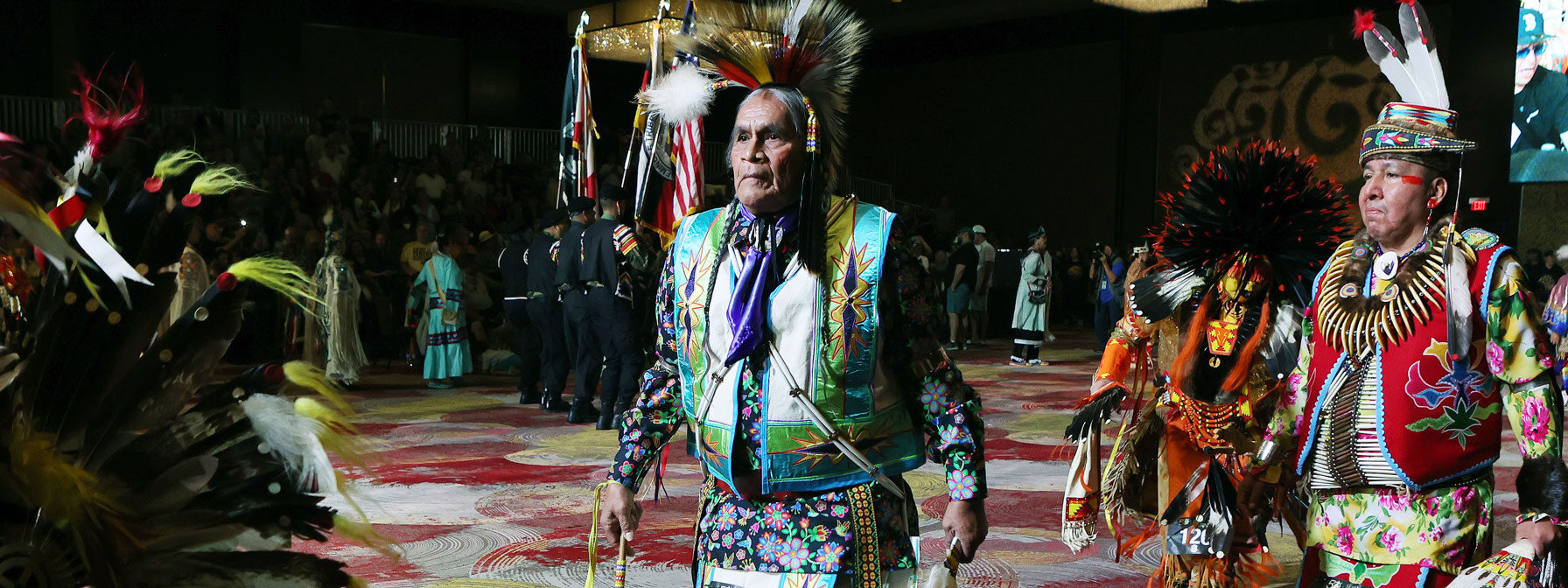
Straight Dancing (Men)
The Straight Dance from Oklahoma Native American Tribes is a formal, tailored, prestigious form of southern dance clothes. The overall effect is of reassuring solidity, with everything closely matched and coordinated. It looks as if it is planned all at one time.
This dance has evolved from the Hethuska Dances. It is believed that the Ponca tribe of American Indians created this style. The Hethuska are dances held by different societies. There are several articles in the standard set. The items that should match are arranged as sets, and everything should be closely coordinated.
Straight Dancing (Men)
The Straight Dance from Oklahoma Native American Tribes is a formal, tailored, prestigious form of southern dance clothes. The overall effect is of reassuring solidity, with everything closely matched and coordinated. It looks as if it is planned all at one time.
This dance has evolved from the Hethuska Dances. It is believed that the Ponca tribe of American Indians created this style. The Hethuska are dances held by different societies. There are several articles in the standard set. The items that should match are arranged as sets, and everything should be closely coordinated.
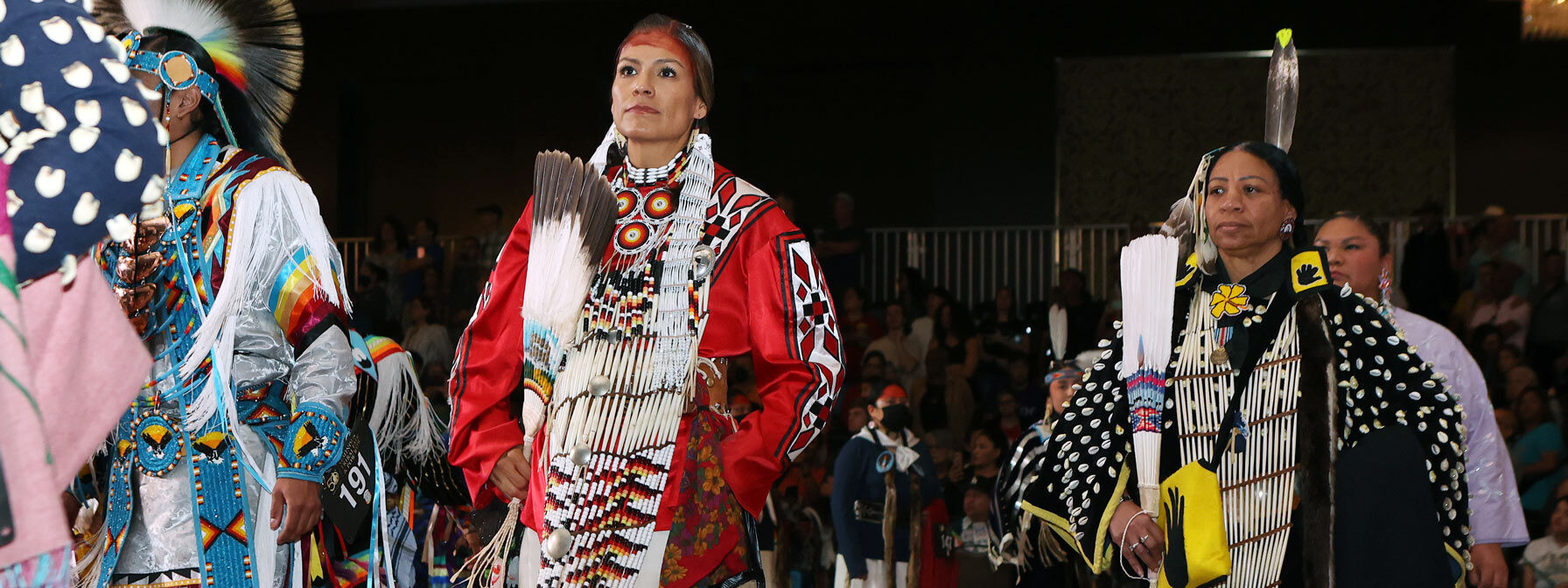
Cloth Dancing (Women)
Ladies Cloth is a form of Native American women’s dress and dance and has both a Northern and Southern style. The Southern style is danced by the Kiowas, Osage, Ponca, and others. The Northern style is danced by the Sioux, Crow, and others. The dance is a slow and graceful one much like the Women’s Buckskin style.
There are many variations among Native American Tribes with the outfit, including wearing a cloth dress or a wool dress and others. The basic outfit consists of several parts. The boots are a high top moccasin that is usually partially beaded. The dress is a long dress with open sleeves. The bottom of the dress is covered in a wrap that is usually a contrasting color or pattern. The wrap is sometimes fringed like a shawl. This style has a breast plate similar to the buckskin dress. This breastplate however has a front and back to it as opposed to the one sided style worn by buckskin dancers. The belt is either silver conchos or beaded with a drag. The women also wear three other items on the belt. They are the awl case, strike a lite bag and tobacco pouch. The dancer sometimes wears a scarf and choker. They also will carry a fan, purse and shawl. This type of dance is a truly beautiful aspect of Native American culture.
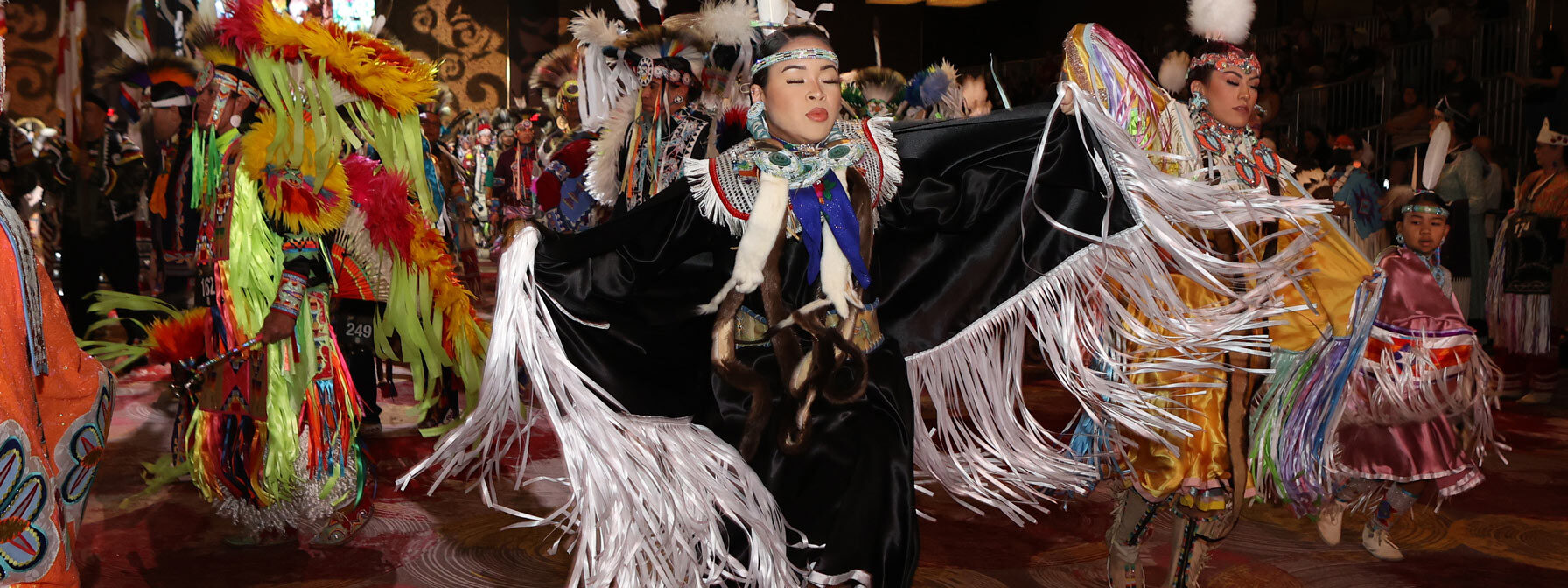
Cloth Dancing (Women)
Ladies Cloth is a form of Native American women’s dress and dance and has both a Northern and Southern style. The Southern style is danced by the Kiowas, Osage, Ponca, and others. The Northern style is danced by the Sioux, Crow, and others. The dance is a slow and graceful one much like the Women’s Buckskin style.
There are many variations among Native American Tribes with the outfit, including wearing a cloth dress or a wool dress and others. The basic outfit consists of several parts. The boots are a high top moccasin that is usually partially beaded. The dress is a long dress with open sleeves. The bottom of the dress is covered in a wrap that is usually a contrasting color or pattern. The wrap is sometimes fringed like a shawl. This style has a breast plate similar to the buckskin dress. This breastplate however has a front and back to it as opposed to the one sided style worn by buckskin dancers. The belt is either silver conchos or beaded with a drag. The women also wear three other items on the belt. They are the awl case, strike a lite bag and tobacco pouch. The dancer sometimes wears a scarf and choker. They also will carry a fan, purse and shawl. This type of dance is a truly beautiful aspect of Native American culture.
Fancy Shawl Dancing (Women)
Ladies Fancy Shawl is the newest form of Native American Women’s Dance, and is quite athletic! Fancy Shawl is often called Northern Shawl, as it does come form the Northern Tribes along the U.S. and Canadian Border.
This is very similar in dancing and the bright colors to the Men’s Fancy Dance. The ladies wear their shawls over their shoulders, and dance by jumping and spinning around, keeping time with the music. They mimic butterflies in flight, and the dance style is quite graceful and light.
Emphasis is paid particularly to the shawls, with elaborate designs, applique, ribbon work, and painting. Long fringe hangs from the edges of the shawl, and flies round.
Fancy Shawl Dancing (Women)
Ladies Fancy Shawl is the newest form of Native American Women’s Dance, and is quite athletic! Fancy Shawl is often called Northern Shawl, as it does come form the Northern Tribes along the U.S. and Canadian Border.
This is very similar in dancing and the bright colors to the Men’s Fancy Dance. The ladies wear their shawls over their shoulders, and dance by jumping and spinning around, keeping time with the music. They mimic butterflies in flight, and the dance style is quite graceful and light.
Emphasis is paid particularly to the shawls, with elaborate designs, applique, ribbon work, and painting. Long fringe hangs from the edges of the shawl, and flies round.
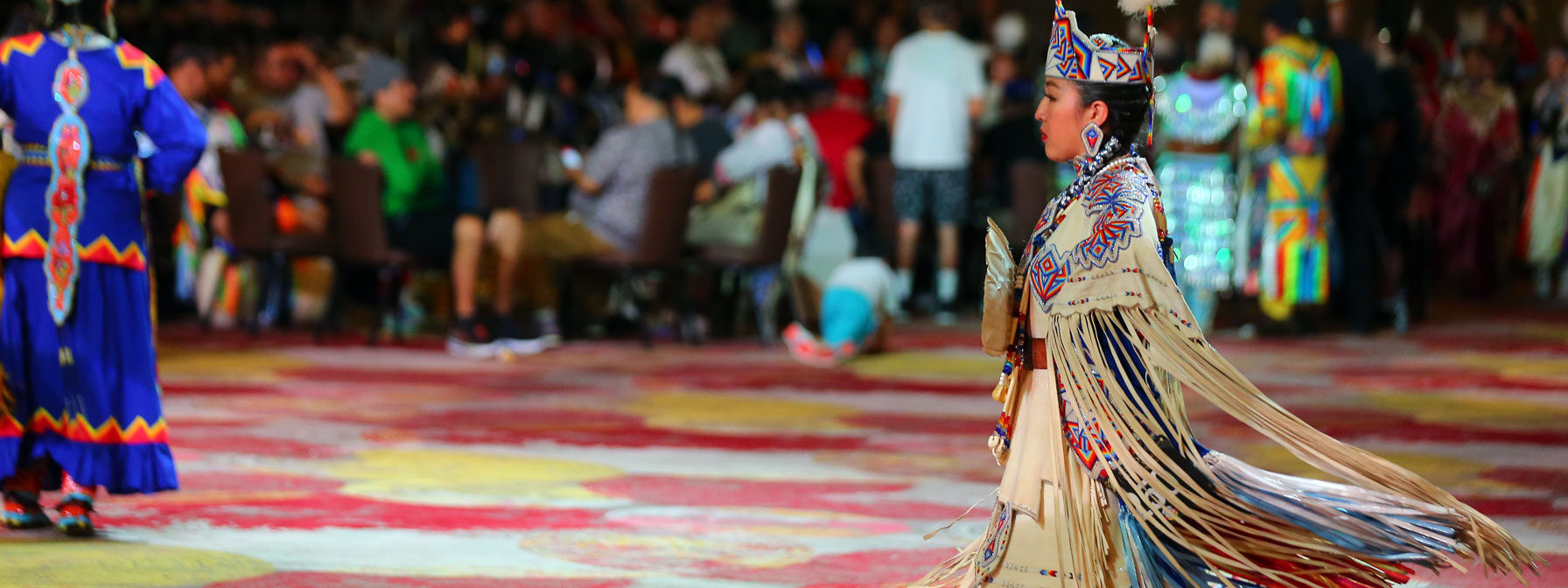
Buckskin Dancing (Women)
One of the oldest form of Native American Women’s Dance is Buckskin. This is a dance of elegance and grace. The movement is smooth and flowing.
The ladies wear fine, hand-crafted buckskin dresses, decorated with intricate bead designs. Northern dresses are fully beaded on the shoulders, or cape. Southern ones, the beadwork is mainly used to accent. They are equally beautiful. The women carry fringed shawls over one arm.
Much like the Men’s Traditional dance, there are many differences in the ouftitting of this women’s style among the various Native American tribes. The jewelry is breath taking. Breastplates made from hair bone pipe, and glass beads can hang to the waist, or all the way to the ankles.
The latter is Northern, the former, Southern. Hair barrettes are hand beaded, and beaded pieces for the fur that hangs from the lady’s hair can be quite intricate indeed. Some ladies, who have either been princesses, or the younger ones who are princesses still, wear beaded crowns, given to them by their societies. The moccasins are either fully beaded (Northern), or accent beaded (Southern).
Ladies’ Buckskin Dancing is slow, and poised. Circling the drum, they bob to the beat of the drum, letting the long fringe on their sleeves sway in time. They carry a beaded purse, swinging it as well, and a shawl, folded on the arm, swaying likewise.
These highly respected American Indian women dance in rhythm with the Drum by swaying and slightly bending at their knees. These movements are very slight. This slight movement, however, creates a beautiful effect in moving their leather fringe in a breezy swaying motion. Northern dresses usually have fully beaded yokes, while Southern dresses have applique beadwork.
Buckskin Dancing (Women)
One of the oldest form of Native American Women’s Dance is Buckskin. This is a dance of elegance and grace. The movement is smooth and flowing.
The ladies wear fine, hand-crafted buckskin dresses, decorated with intricate bead designs. Northern dresses are fully beaded on the shoulders, or cape. Southern ones, the beadwork is mainly used to accent. They are equally beautiful. The women carry fringed shawls over one arm.
Much like the Men’s Traditional dance, there are many differences in the ouftitting of this women’s style among the various Native American tribes. The jewelry is breath taking. Breastplates made from hair bone pipe, and glass beads can hang to the waist, or all the way to the ankles.
The latter is Northern, the former, Southern. Hair barrettes are hand beaded, and beaded pieces for the fur that hangs from the lady’s hair can be quite intricate indeed. Some ladies, who have either been princesses, or the younger ones who are princesses still, wear beaded crowns, given to them by their societies. The moccasins are either fully beaded (Northern), or accent beaded (Southern).
Ladies’ Buckskin Dancing is slow, and poised. Circling the drum, they bob to the beat of the drum, letting the long fringe on their sleeves sway in time. They carry a beaded purse, swinging it as well, and a shawl, folded on the arm, swaying likewise.
These highly respected American Indian women dance in rhythm with the Drum by swaying and slightly bending at their knees. These movements are very slight. This slight movement, however, creates a beautiful effect in moving their leather fringe in a breezy swaying motion. Northern dresses usually have fully beaded yokes, while Southern dresses have applique beadwork.
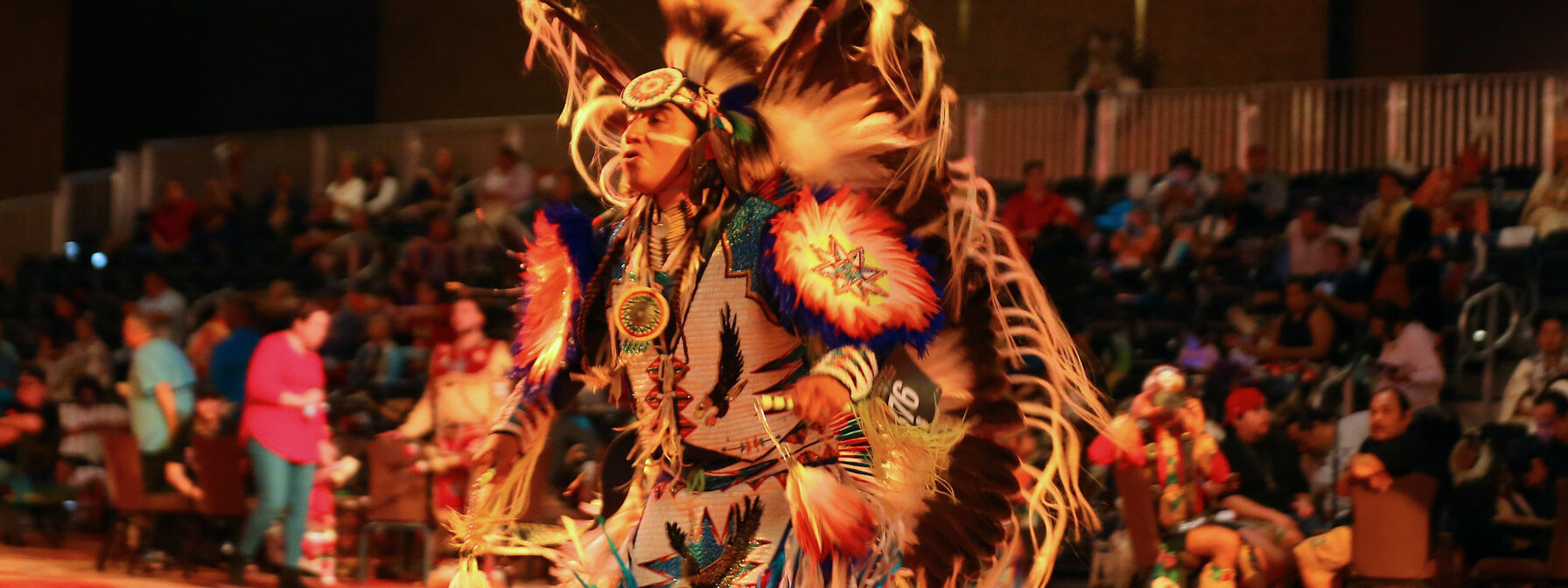
Fancy Feather Dancing – Native American Fancy Dance (Men)
The Oklahoma Feather Dance or “Fancy Dance” is one of the most popular styles of Native American dance and outfits seen at modern pow wows. The Fancy Dance outfit, as such, has no single Native American tribes.
The “Fancy Dance” originated as Fancy War Dance by the Hethuska Society in Oklahoma. The individual who invented the dance was Gus McDonald. He was also the first World Champion Fancy War Dancer. The McDonald family, specifically Julep Farmer McDonald, the Ponca Tribal Matriarch still presents the trophy to the Fancy War Dance Champion each year because of this family honor.
Gus McDonald also invented the “feather pull” which is another contest of the Fancy Dancer’s agility and ability to keep time with the drum. This dance is done only by permission of the McDonald family.
The McDonald Family Song is also sung in honor of Gus McDonald’s honor to the Ponca tribe and to the pow-wow world. This war dance song is only started by permission of the McDonald family and in their presence. Gus McDonald, Ponca and the first World Champion Fancy Dancer, should be recognized for his contribution to the Native American heritage and history.
The most obvious items in the Fancy Dance outfit are great amounts of loom beaded sets of suspenders, belt cuffs, headband, and armbands. The designs are usually matching in all items and of a rainbow feather or geometric design. Beaded medallions are on the forehead and bustles are also quite common. Occasionally a breastplate will be used in place of the beaded suspenders or in conjunction with them.
The other trademark for Fancy Dancers is the use of large feather bustles. Currently most bustles are color-coordinated with the bead work by using large amounts of feather hackles dyed the appropriate colors.
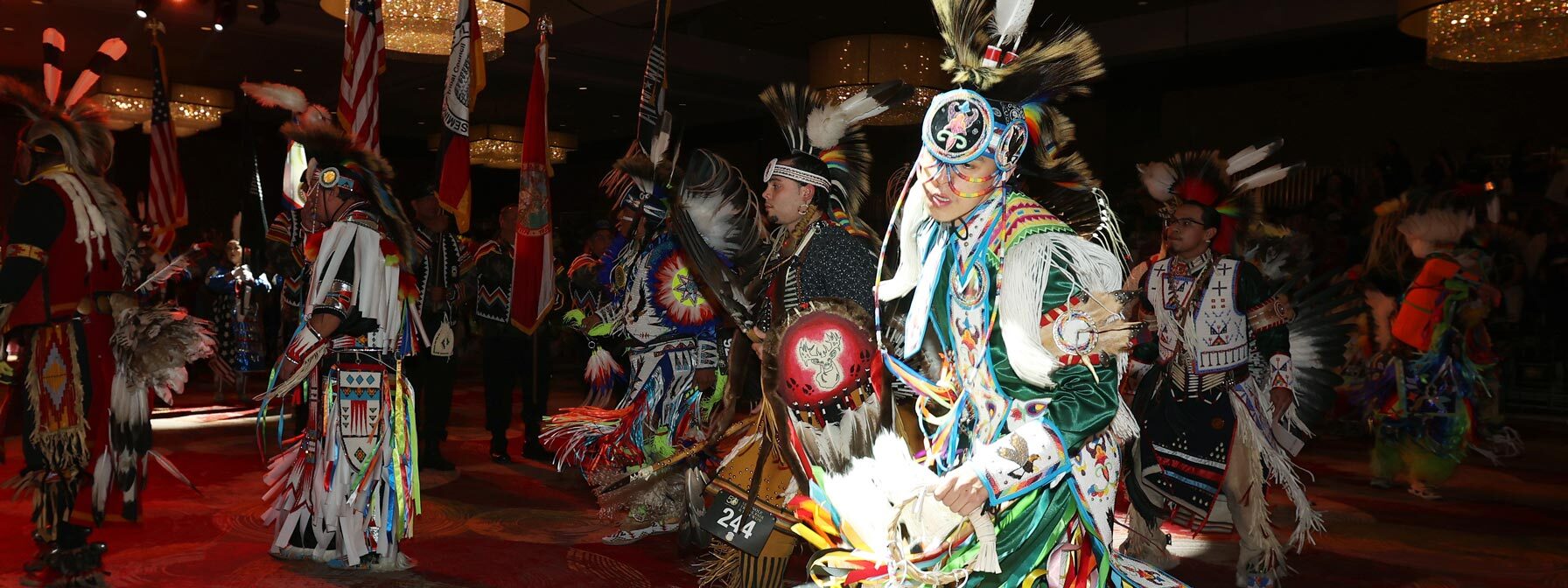
Fancy Feather Dancing – Native American Fancy Dance (Men)
The Oklahoma Feather Dance or “Fancy Dance” is one of the most popular styles of Native American dance and outfits seen at modern pow wows. The Fancy Dance outfit, as such, has no single Native American tribes.
The “Fancy Dance” originated as Fancy War Dance by the Hethuska Society in Oklahoma. The individual who invented the dance was Gus McDonald. He was also the first World Champion Fancy War Dancer. The McDonald family, specifically Julep Farmer McDonald, the Ponca Tribal Matriarch still presents the trophy to the Fancy War Dance Champion each year because of this family honor.
Gus McDonald also invented the “feather pull” which is another contest of the Fancy Dancer’s agility and ability to keep time with the drum. This dance is done only by permission of the McDonald family.
The McDonald Family Song is also sung in honor of Gus McDonald’s honor to the Ponca tribe and to the pow-wow world. This war dance song is only started by permission of the McDonald family and in their presence. Gus McDonald, Ponca and the first World Champion Fancy Dancer, should be recognized for his contribution to the Native American heritage and history.
The most obvious items in the Fancy Dance outfit are great amounts of loom beaded sets of suspenders, belt cuffs, headband, and armbands. The designs are usually matching in all items and of a rainbow feather or geometric design. Beaded medallions are on the forehead and bustles are also quite common. Occasionally a breastplate will be used in place of the beaded suspenders or in conjunction with them.
The other trademark for Fancy Dancers is the use of large feather bustles. Currently most bustles are color-coordinated with the bead work by using large amounts of feather hackles dyed the appropriate colors.
Fancy Feather Dancing – Native American Fancy Dance (Men)
The Oklahoma Feather Dance or “Fancy Dance” is one of the most popular styles of Native American dance and outfits seen at modern pow wows. The Fancy Dance outfit, as such, has no single Native American tribes.
The “Fancy Dance” originated as Fancy War Dance by the Hethuska Society in Oklahoma. The individual who invented the dance was Gus McDonald. He was also the first World Champion Fancy War Dancer. The McDonald family, specifically Julep Farmer McDonald, the Ponca Tribal Matriarch still presents the trophy to the Fancy War Dance Champion each year because of this family honor.
Gus McDonald also invented the “feather pull” which is another contest of the Fancy Dancer’s agility and ability to keep time with the drum. This dance is done only by permission of the McDonald family.
The McDonald Family Song is also sung in honor of Gus McDonald’s honor to the Ponca tribe and to the pow-wow world. This war dance song is only started by permission of the McDonald family and in their presence. Gus McDonald, Ponca and the first World Champion Fancy Dancer, should be recognized for his contribution to the Native American heritage and history.
The most obvious items in the Fancy Dance outfit are great amounts of loom beaded sets of suspenders, belt cuffs, headband, and armbands. The designs are usually matching in all items and of a rainbow feather or geometric design. Beaded medallions are on the forehead and bustles are also quite common. Occasionally a breastplate will be used in place of the beaded suspenders or in conjunction with them.
The other trademark for Fancy Dancers is the use of large feather bustles. Currently most bustles are color-coordinated with the bead work by using large amounts of feather hackles dyed the appropriate colors.
Grass Dancing (Men)
Originally done as a Warrior Society Dance, it has evolved over the years. It has further evolved into a highly-competitive form of northern dancing.
Grass Dancers always stands out by virtue of two things: his dancing style and his outfit. His dancing has been described often by these words:” gutsy, swinging, slick, old-time,” etc. His outfit stands out by virtue of the almost complete absence of feathers, for aside from the roach feather, there are no bustles of any kind to be seen. The outfit consists of shirt and pants, with beaded or otherwise decorated belt and side tabs, armbands, cuffs, and front and back apron, with matched headband and moccasins, if available. Ribbons and fringe are the only mobile parts of his outfit, other than the roach feather. In other words, the outfit is made to conform to the style of dancing.
Some believe that grass dancing came from young boys tying grass on their outfits. Before a dance could be held on the prairie the grass had to be stomped down. This is where many of the movements are believed to com e from. Afterwards the dancers would tie the grass to their outfit. Many believe that the Omaha tribe originated the dance in their warrior societies.
The name “Grass Dance” comes from the custom of some tribes wearing braided grass in their belts.
Grass Dancing (Men)
Originally done as a Warrior Society Dance, it has evolved over the years. It has further evolved into a highly-competitive form of northern dancing.
Grass Dancers always stands out by virtue of two things: his dancing style and his outfit. His dancing has been described often by these words:” gutsy, swinging, slick, old-time,” etc. His outfit stands out by virtue of the almost complete absence of feathers, for aside from the roach feather, there are no bustles of any kind to be seen. The outfit consists of shirt and pants, with beaded or otherwise decorated belt and side tabs, armbands, cuffs, and front and back apron, with matched headband and moccasins, if available. Ribbons and fringe are the only mobile parts of his outfit, other than the roach feather. In other words, the outfit is made to conform to the style of dancing.
Some believe that grass dancing came from young boys tying grass on their outfits. Before a dance could be held on the prairie the grass had to be stomped down. This is where many of the movements are believed to com e from. Afterwards the dancers would tie the grass to their outfit. Many believe that the Omaha tribe originated the dance in their warrior societies.
The name “Grass Dance” comes from the custom of some tribes wearing braided grass in their belts.
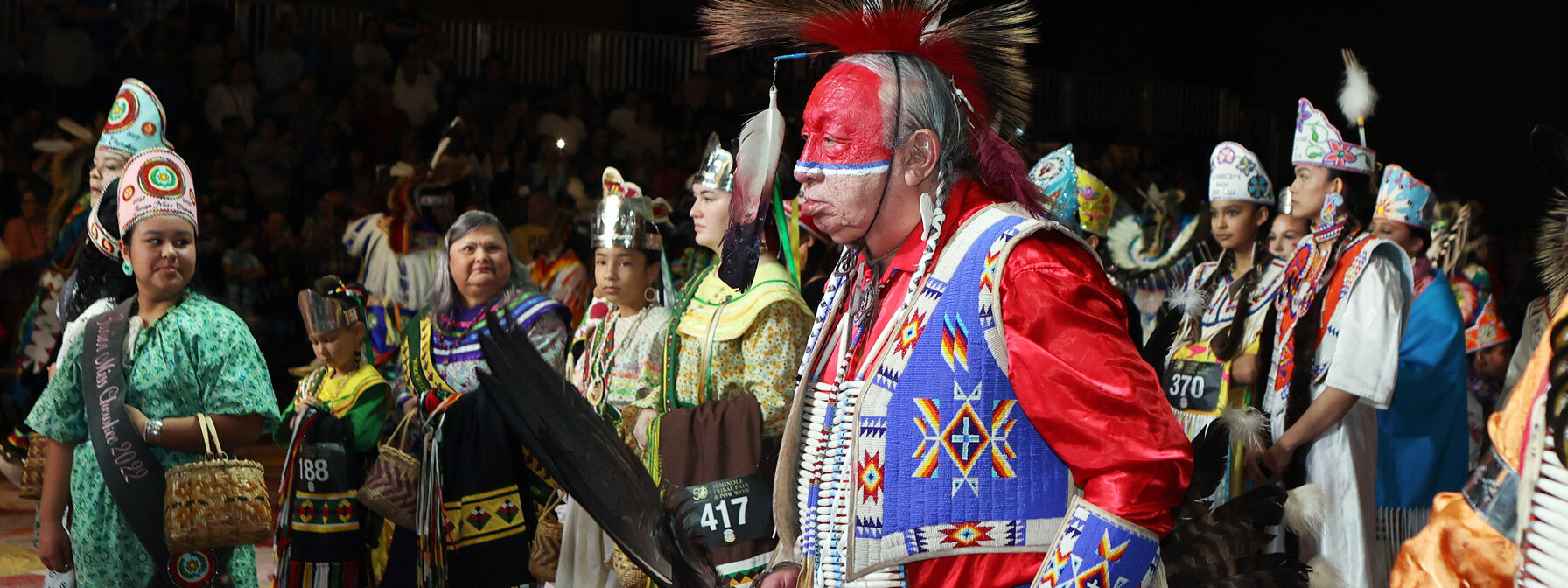
Northern Traditional Dancing (Men & Women)
The Northern Traditional Dancer is a modern evolution of tribal outfits from the tribes of the Northern Plains such as Sioux, Blackfoot, Crow, Omaha and others.
Below is some information about the outfit’s parts. It must be stressed that this is only a brief description as variations do exist from area to area and from tribe to tribe. Careful observation and research be undertaken before starting to construct this type outfit. On his head the Traditional Dancer wears a roach made of porcupine hair and deer tail hair. The longer porcupine hair is preferred because of it’s movement. The roach spreader can be made of bone, metal, rawhide or leather. It can be carved, beaded, painted, etc. or just left plain. The roach feathers are inserted in sockets on the spreader, with two roach feathers being the usual number. The rocker spreader, popular with fancy dancers, is rarely seen. Occasionally one will see dancers wearing beaded headbands, often decorated with medallions or drops. Quilled wheels can also be worn in the hair.
Most dancers wear a shirt, either with or without ribbon decoration. Over the shirt is worn a breastplate that usually extends below the waist. Around the neck is a choker either of hair pipes and beads or a beaded strip. Many dancers also wear two bandoliers of hair pipes and beads or a 3 to 5 inch strip of otter or other fur decorated with mirrors or a combination of both. A vest can be worn either of cloth or leather and some vests are beaded.
Arm bands and cuffs can be either beaded or metal or a combination of the two such as beaded cuffs with metal arm bands. The breech cloth or aprons can be made of either cloth or leather and range from plain to heavily decorated. Around the waist many dancers wear a belt, which can be beaded or decorated with metal tacks or conchos.
Northern Traditional Dancing (Men & Women)
The Northern Traditional Dancer is a modern evolution of tribal outfits from the tribes of the Northern Plains such as Sioux, Blackfoot, Crow, Omaha and others.
Below is some information about the outfit’s parts. It must be stressed that this is only a brief description as variations do exist from area to area and from tribe to tribe. Careful observation and research be undertaken before starting to construct this type outfit. On his head the Traditional Dancer wears a roach made of porcupine hair and deer tail hair. The longer porcupine hair is preferred because of it’s movement. The roach spreader can be made of bone, metal, rawhide or leather. It can be carved, beaded, painted, etc. or just left plain. The roach feathers are inserted in sockets on the spreader, with two roach feathers being the usual number. The rocker spreader, popular with fancy dancers, is rarely seen. Occasionally one will see dancers wearing beaded headbands, often decorated with medallions or drops. Quilled wheels can also be worn in the hair.
Most dancers wear a shirt, either with or without ribbon decoration. Over the shirt is worn a breastplate that usually extends below the waist. Around the neck is a choker either of hair pipes and beads or a beaded strip. Many dancers also wear two bandoliers of hair pipes and beads or a 3 to 5 inch strip of otter or other fur decorated with mirrors or a combination of both. A vest can be worn either of cloth or leather and some vests are beaded.
Arm bands and cuffs can be either beaded or metal or a combination of the two such as beaded cuffs with metal arm bands. The breech cloth or aprons can be made of either cloth or leather and range from plain to heavily decorated. Around the waist many dancers wear a belt, which can be beaded or decorated with metal tacks or conchos.
Northern Traditional Dancing (Men & Women)
The Northern Traditional Dancer is a modern evolution of tribal outfits from the tribes of the Northern Plains such as Sioux, Blackfoot, Crow, Omaha and others.
Below is some information about the outfit’s parts. It must be stressed that this is only a brief description as variations do exist from area to area and from tribe to tribe. Careful observation and research be undertaken before starting to construct this type outfit. On his head the Traditional Dancer wears a roach made of porcupine hair and deer tail hair. The longer porcupine hair is preferred because of it’s movement. The roach spreader can be made of bone, metal, rawhide or leather. It can be carved, beaded, painted, etc. or just left plain. The roach feathers are inserted in sockets on the spreader, with two roach feathers being the usual number. The rocker spreader, popular with fancy dancers, is rarely seen. Occasionally one will see dancers wearing beaded headbands, often decorated with medallions or drops. Quilled wheels can also be worn in the hair.
Most dancers wear a shirt, either with or without ribbon decoration. Over the shirt is worn a breastplate that usually extends below the waist. Around the neck is a choker either of hair pipes and beads or a beaded strip. Many dancers also wear two bandoliers of hair pipes and beads or a 3 to 5 inch strip of otter or other fur decorated with mirrors or a combination of both. A vest can be worn either of cloth or leather and some vests are beaded.
Arm bands and cuffs can be either beaded or metal or a combination of the two such as beaded cuffs with metal arm bands. The breech cloth or aprons can be made of either cloth or leather and range from plain to heavily decorated. Around the waist many dancers wear a belt, which can be beaded or decorated with metal tacks or conchos.
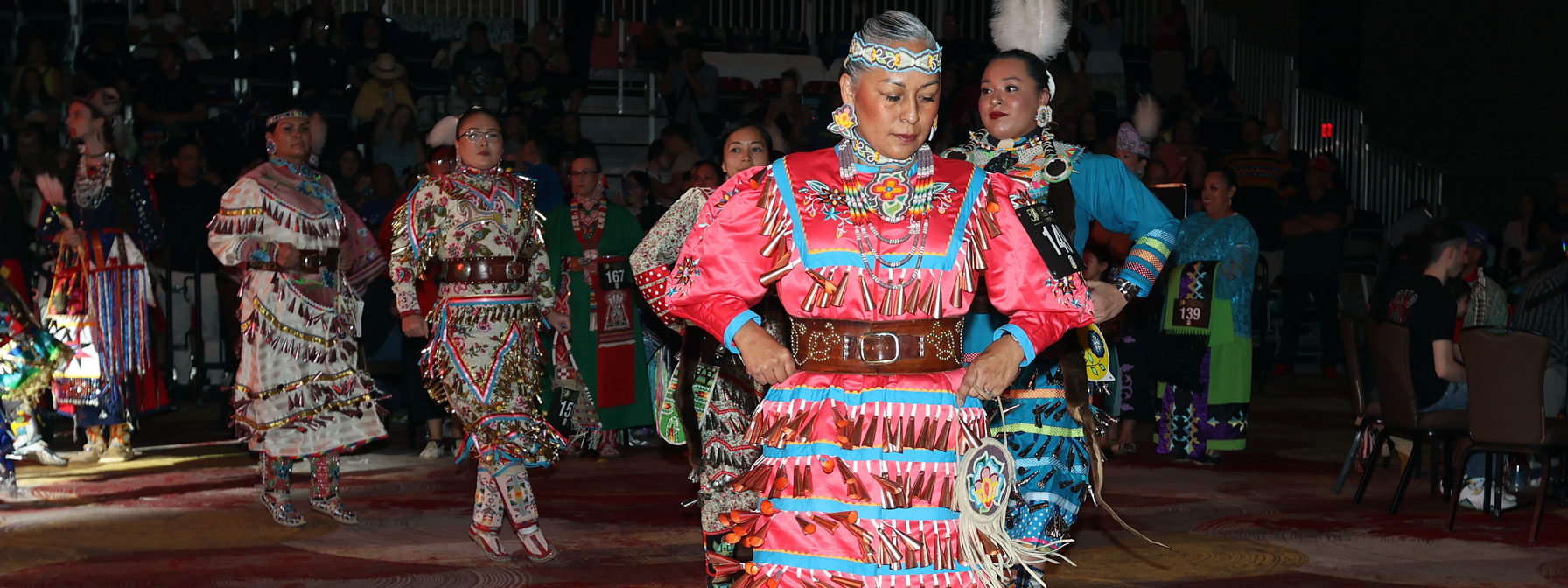
Jingle Dancing (Women)
Jingle Dress is also called a Prayer Dress. There are differences in the origins of the dress among the tribes. The dress was seen in a dream, as an object to bring healing to afflicted people. It comes from the Northern Tribe Ojibewea or Chippewa, along the Canadian border.
A Medicine Man’s Granddaughter became very ill one day. In a dream, his spirit guides told him to make a Jingle dress for her and have her dance in it. This, he was told would heal her. When the outfit was finished, the tribe assembled for a dance. On her first time around, the illness would not permit her to dance and she was carried. As time went on she was soon dancing in the circle.
Jingle Dresses are decorated with rolled up snuff can lids that are hung with ribbon. The ribbon is then sewed to the dress, The jingles are placed close enough so they can hit together, causing a beautiful sound. If one were to close their eyes as the Jingle dancer passes, it would sound as though it were raining!
Jingle Dancing (Women)
Jingle Dress is also called a Prayer Dress. There are differences in the origins of the dress among the tribes. The dress was seen in a dream, as an object to bring healing to afflicted people. It comes from the Northern Tribe Ojibewea or Chippewa, along the Canadian border.
A Medicine Man’s Granddaughter became very ill one day. In a dream, his spirit guides told him to make a Jingle dress for her and have her dance in it. This, he was told would heal her. When the outfit was finished, the tribe assembled for a dance. On her first time around, the illness would not permit her to dance and she was carried. As time went on she was soon dancing in the circle.
Jingle Dresses are decorated with rolled up snuff can lids that are hung with ribbon. The ribbon is then sewed to the dress, The jingles are placed close enough so they can hit together, causing a beautiful sound. If one were to close their eyes as the Jingle dancer passes, it would sound as though it were raining!
Pow Wow Etiquette
1. Be on time. The committee is doing everything possible to ensure that activities begin and run smoothly. Please cooperate in this regard.
2. Appropriate dress and behavior is required in the arena. Anyone unwilling to abide by this rule will be asked to leave by the Arena Director. (If you are going to dance, try to wear dance clothes.)
3. Arena benches are reserved for dancers. Dancers wishing to reserve a space on the bench should place a blanket in that space before the dance begins. Please do not sit on someone else’s blanket unless invited. Uncovered benches are considered unreserved.
4. Listen to the Master of Ceremonies. He will announce who is to dance, and when.
5. Respect the position of the Head Man and Head Woman Dancers. Their role entitles them to start each song or set of songs. Please wait until they have started to dance before you join in.
6. Dance as long and as hard as you can. When not dancing, be quiet and respect the arena
7. Be aware that someone standing behind you may not be able to see over you. Make room, step aside, sit, or kneel if someone is behind you.
8. Show respect to the flags and Honor Songs by standing during “special” songs.” Stand in place until the sponsors of the song have danced a complete circle and have come around you, and then join in. If you are not dancing, continue to stand quietly until the song is completed.
9. While dancing at any paw wow, honor the protocol of the sponsoring group.
10. Some songs require that you dance only if you are familiar with the routine or are eligible to participate. Trot dances, Snake, Buffalo, etc. require particular steps or routines. If you are not familiar with these dances, observe and learn. Watch the head dancers to learn the procedures. Only veterans are permitted to dance some veteran’s songs, unless otherwise stated; listen to the MC for instructions.
11. The Flag Song, or Indian National Anthem, is sung when the American Flag is raised or lowered. Please stand and remove hats during the singing of this song. It is not a song for dancing.
12. Powwows are usually non-profit. It depends upon donations, raffles, blanket dances, etc. for support. Donations are encouraged as a way to honor someone. Any participant can drop money onto the blanket to aid in the powwow expenses. Support the committee and buy raffle tickets.
13. Certain items of religious significance should be worn only by those qualified to do so. Respect the traditions.
14. Giveaways, attributes of Indian generosity, are held at many dances. They are acknowledgments of appreciation to recipients for honor given. When receiving a gift, the recipient thanks everyone involved in the giving. Note: all specials and giveaways must be coordinated with the Master of Ceremonies. Please remember that it is traditional to make a monetary contribution to the drum for this request – clear this through the MC.
15. The Drums are sometimes closed, check with the head singer for permission to sing.
16. If at any time you are uncertain of procedure or etiquette, please check with the MC, Arena Director, or head singer. They will be glad to help you with your questions.
17. Take a chair. Most powwows will not have seating for the public or enough seating for everyone. Also remember that the benches in the arena are for dancers only.
18. No alcohol or drugs are allowed at powwows.
19. If taking pictures, asked the dancer first. Remember common courtesy and ask permission. Group photographs are usually alright to take, but you might want to ask the committee first.
Remember that in each area you travel to and visit, things can and will be slightly different than your area. Different groups and have different customs and methods of doing things. Different is not wrong, just different. Be respectful of the uniqueness of each area.
